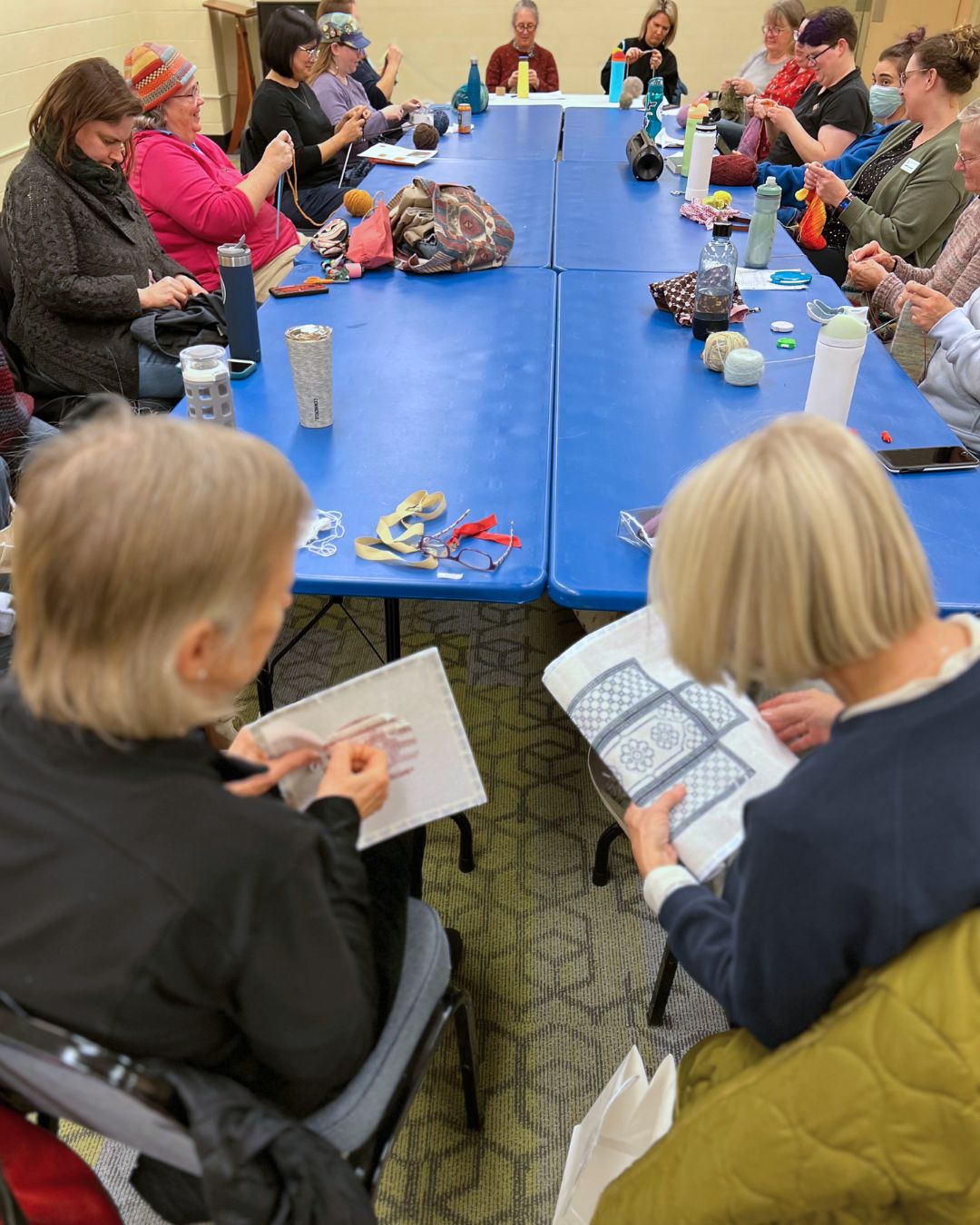On a bone-chilling Wednesday evening in February, the Century Room on the lower level of the Jefferson-Madison Regional Library’s Gordon Avenue branch is set up for what looks like an average craft group meeting. People filter in, say hello, and catch up with one another as they dig through a tub of yarn, grab a pair of needles, or browse the selection of knitting books displayed on a cart. As seats fill up around the large table in the center of the room, participants start focusing on the projects they brought to work on—sweaters, scarves, baby booties, embroidery. Branch Manager Camille Thompson finds the folks who are new to knitting, or have questions, and helps them get started on a basic project with supplies provided by the library.
It all seems so lovely and homespun until Young Adult Librarian Britt Ford greets the room: “Welcome, Deadly Knitters,” she says. “Tonight, we have some rather grisly options for your listening pleasure.” She reads a list of true crime podcast episode titles and participants indicate the group favorite with a show of hands. That’s when it becomes clear these folks have one thing on their mind…okay, maybe two—handcrafts and murder.
Described as a “true crime knit-along,” Deadly Knits has gained a following since it began in early 2023. With as many as 20 participants each month, most of whom are regulars, it is easily one of the most successful adult programs at Gordon Avenue.
Ford says the inspiration for the program came from a TikTok video teaching the steps of a knit stitch by way of a memorable mantra: “Stab it. Strangle it. Scoop out its guts. Throw it off a cliff.” A fan of true crime herself, she had a hunch that other knitters would enjoy the mix of macabre and yarn. She ran the idea past a friend whose reply, “That sounds deadly,” sealed the program’s fate.
“There seems to be an overlap in fans of true crime and fiber arts enthusiasts,” says Thompson. “Hand crafters are always looking for something to listen to while they work—audiobooks, podcasts, music, and casual conversation all lend themselves to an entertaining crafting experience. The true crime aspect marries two niche interests in a format that works perfectly.”
The audio aspect of the program removes the pressure of making small talk or coming up with conversation topics—listening and working quietly is just as welcome in the group as adding to the passionate discussions of the crime of the month.
“I think this makes the program more neurodivergent-friendly,” says Ford. “It doesn’t require interaction or conversation, and choosing yarn allows for sensory needs to be met. The group fills the need to be around others of similar interest without the expectation of making conversation.”
Between the shared interests of the group and the consistency of the monthly meetings, many participants say it has become a source of social connection. The format also works well for busy folks who don’t have time to read a whole book or take a large project-based craft workshop—no preparation is necessary to attend.
Participant Debbie Wong appreciates that aspect of the group. “Listening to the podcast together allows everyone to participate in the discussion without the pressure of being prepared,” she said. “In our busy days, it’s nice to be able to join in an activity where you can just show up and be a part of it.”
Amy Sobek said she finds community and “a great environment for learning and practicing something new. Living in an isolating digital age of screens, and after a years-long pandemic, it kinda helps to connect and beat isolation,” she said.
Jodi Roper concurs, saying she had recently retired when she found the Deadly Knits program. “I knew it would be good for my mental health to have social interactions with people who have the same interests that I do.”
According to Thompson, Deadly Knits exemplifies the public library mission coming to life. “I recently read an article about libraries working to solve the epidemic of loneliness,” she said. “Deadly Knits is a great example of using our creativity and individual skills as librarians to make space for connection in a unique way. This part of librarianship—connecting people with each other—is one of my favorite things about our profession.”
Jennifer MacAdam-Miller, Public Communications Specialist, Jefferson-Madison Regional Library
Camille Thompson, Branch Manager – Gordan Avenue, Jefferson-Madison Regional Library
Britt Ford, Young Adult Librarian – Jefferson-Madison Regional Library








